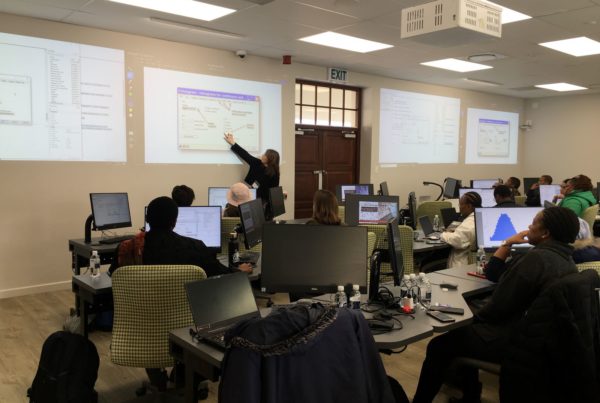From 21-22 August 2024, Resep hosted its 8th annual Quantitative Education Research (QER) conference at STIAS, Stellenbosch. Among the more than 100 attendees were academics, students, government officials, NGOs representatives and other stakeholders. Speakers, chairs and participants collectively provided an overview of key trends in South African education and profiled new research. In this synopsis of the 2-day programme, some key insights across all presentations are considered under eight emerging conference themes.
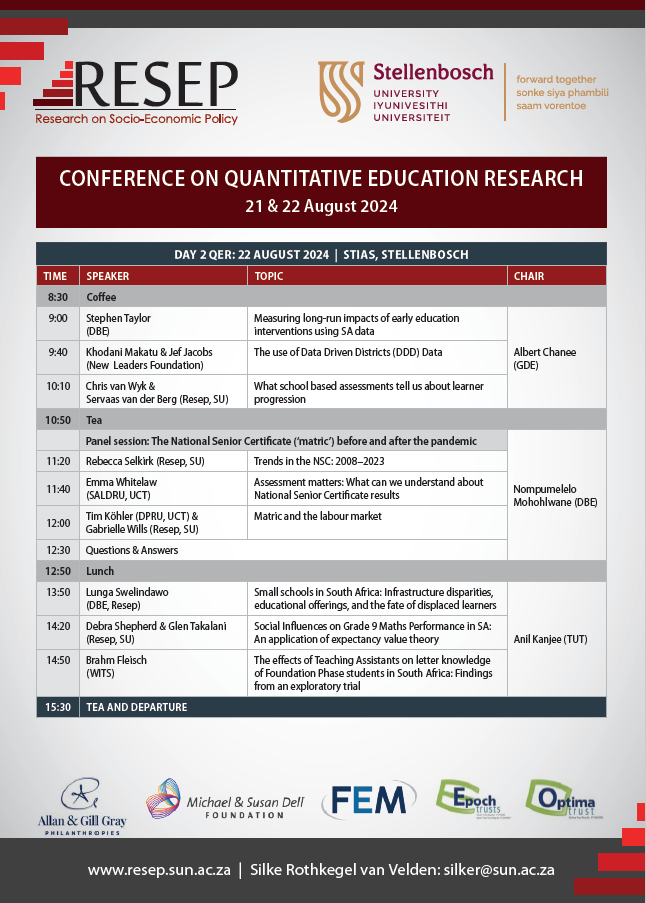
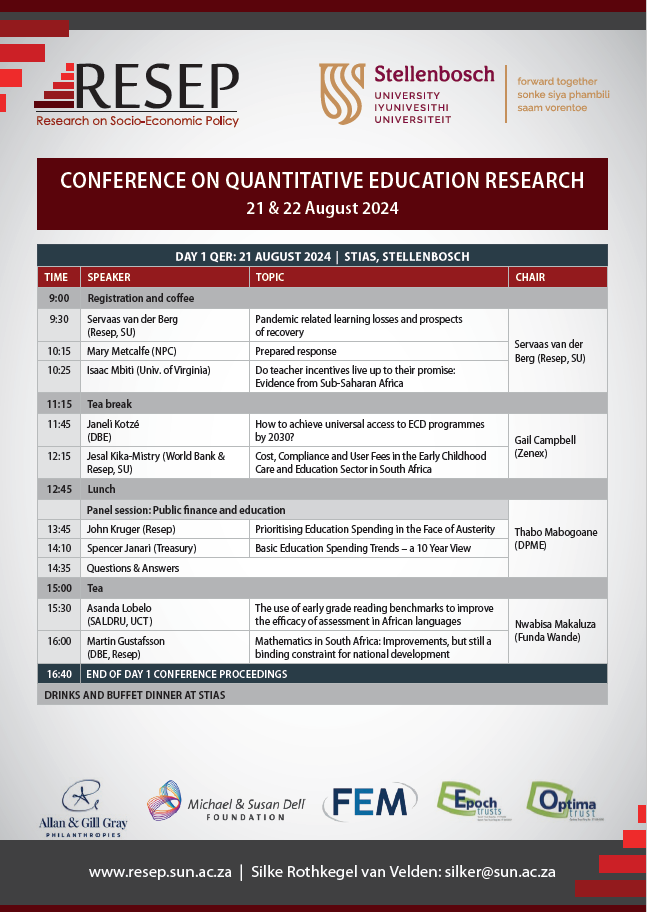
Click on this link to download the conference programme.
- Covid-19 learning losses and recovery
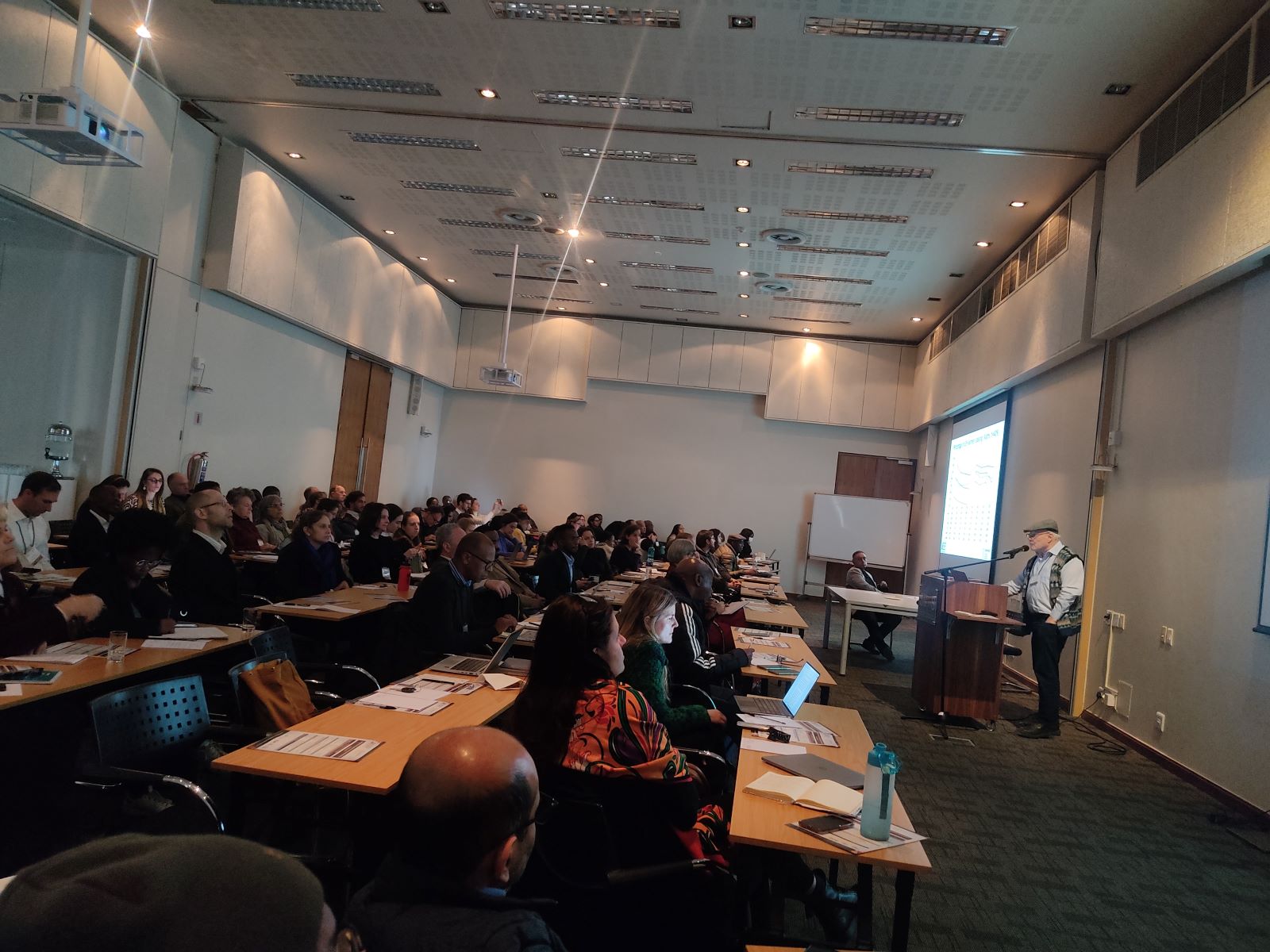 Servaas van der Berg (Resep), commenced day 1 by centering our focus on learning. His presentation was a reminder of significant learning losses, rising inequality in learning and the large adjustments seen to learner flows in the South African education system during and post-Covid-19. Although some learning recovery is implied in one or two studies, his presentation was also a stark reminder of the lack of national standardized assessments in South Africa to regularly track recovery efforts (and learning) in most of the system.
Servaas van der Berg (Resep), commenced day 1 by centering our focus on learning. His presentation was a reminder of significant learning losses, rising inequality in learning and the large adjustments seen to learner flows in the South African education system during and post-Covid-19. Although some learning recovery is implied in one or two studies, his presentation was also a stark reminder of the lack of national standardized assessments in South Africa to regularly track recovery efforts (and learning) in most of the system.
- Teacher Incentives
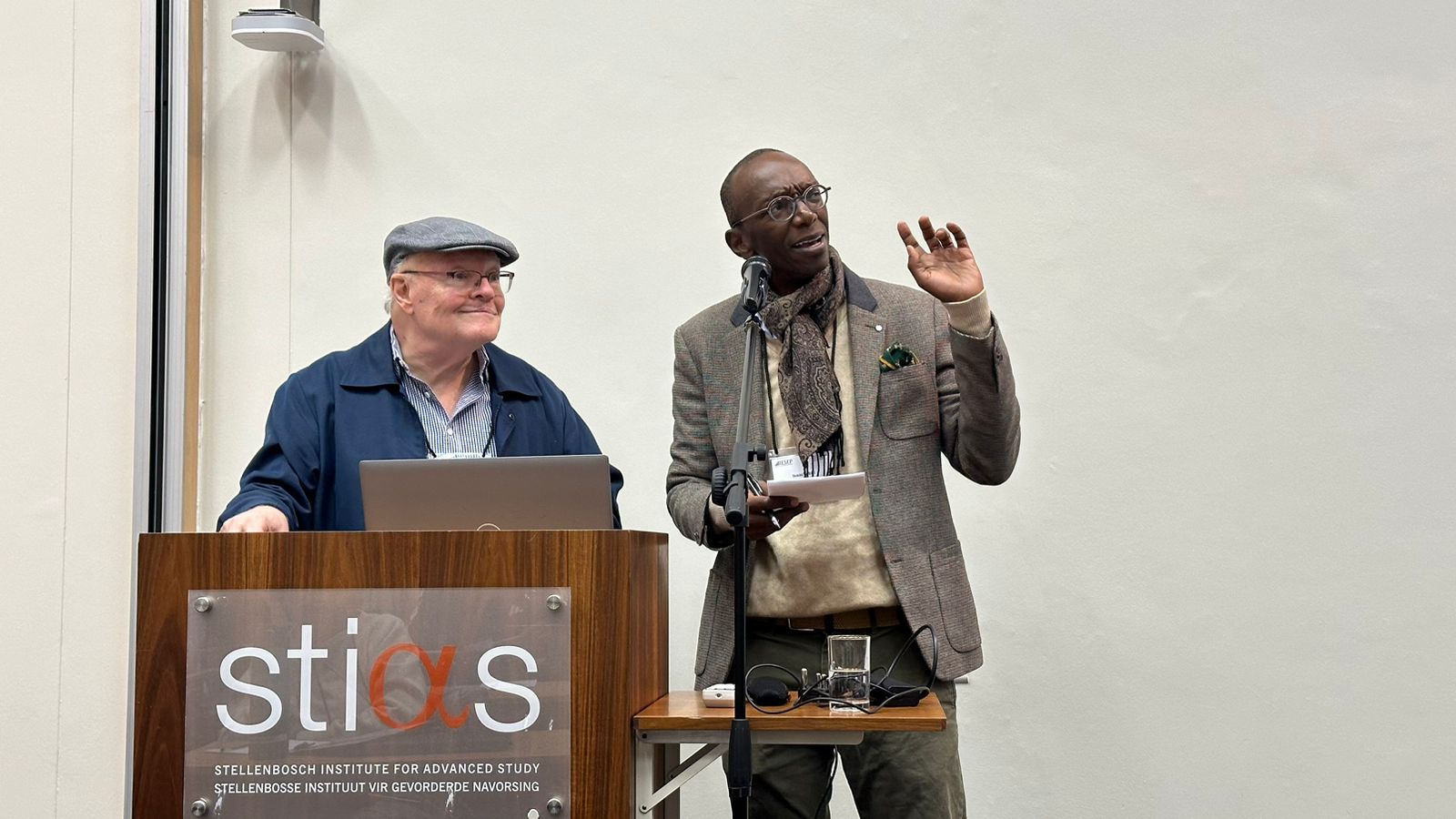 We were fortunate to have Professor Isaac Mbiti from the University of Virginia as a keynote speaker. He provided an overview of years of research on teacher incentive programme implementations in low-middle-income countries. Mbiti’s presentation demonstrated that teacher incentives work when well-designed because they centre teaching on student learning. However, no clear evidence exists on whether the test score impacts of teacher incentive programmes sustain over the long-term.
We were fortunate to have Professor Isaac Mbiti from the University of Virginia as a keynote speaker. He provided an overview of years of research on teacher incentive programme implementations in low-middle-income countries. Mbiti’s presentation demonstrated that teacher incentives work when well-designed because they centre teaching on student learning. However, no clear evidence exists on whether the test score impacts of teacher incentive programmes sustain over the long-term.
- Strategic education planning, ECE and small schools
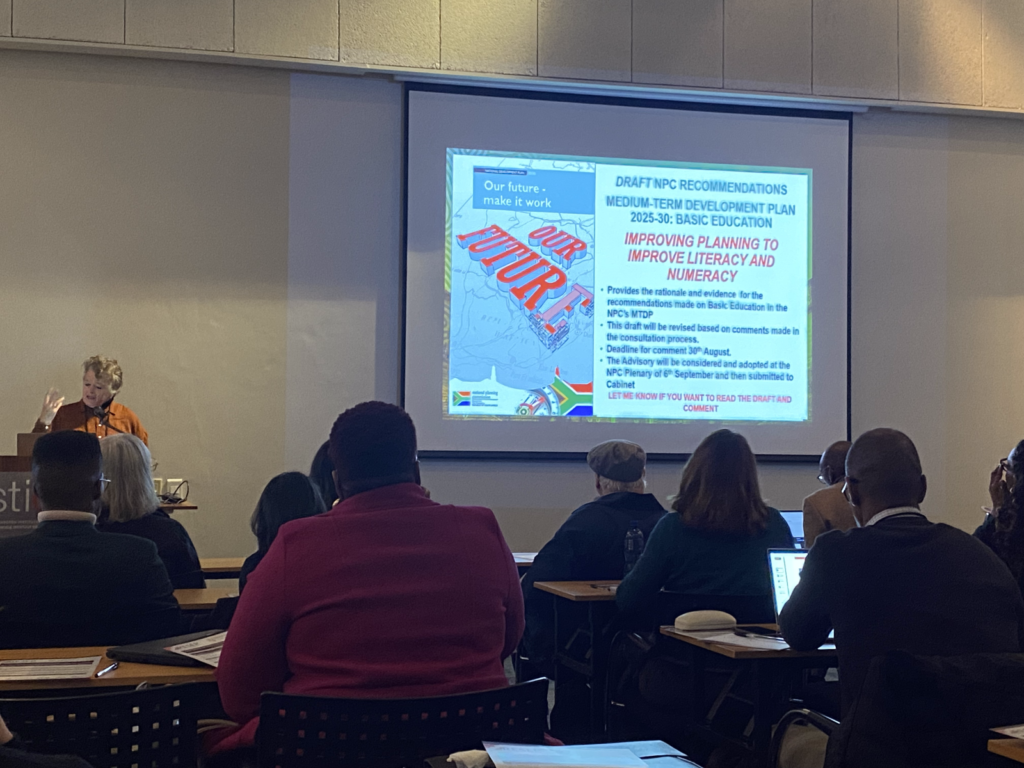 Education priorities and strategies are regularly refined or developed by government. Mary Metcalfe (NPC), in her presentation, outlined key elements and recommendations from the National Planning Commission’s (NPC) advisories on Early Childhood Development (ECD) and Basic Education for the MDTP 2025/30. As a mechanism to improve support to teachers, she stressed the importance of equalising spending and support across districts, particularly with respect to available curriculum advisors.
Education priorities and strategies are regularly refined or developed by government. Mary Metcalfe (NPC), in her presentation, outlined key elements and recommendations from the National Planning Commission’s (NPC) advisories on Early Childhood Development (ECD) and Basic Education for the MDTP 2025/30. As a mechanism to improve support to teachers, she stressed the importance of equalising spending and support across districts, particularly with respect to available curriculum advisors.
Janeli Kotzé, from the Department of Basic Education (DBE), provided a strategic overview of plans to expand both access and the quality of ECD service provisioning and outlined the theory of change undergirding these efforts. Jesal Kika-Mistry (World Bank, RESEP) drawing on a working paper for Ilifa Labantwana (co-authored with Gabrielle Wills) then highlighted the importance of ECD subsidies in reducing barriers to access in the form of high user fees, while demonstrating in her presentation that ECD subsidies may also raise the quality of services offered at Early Learning Programmes.
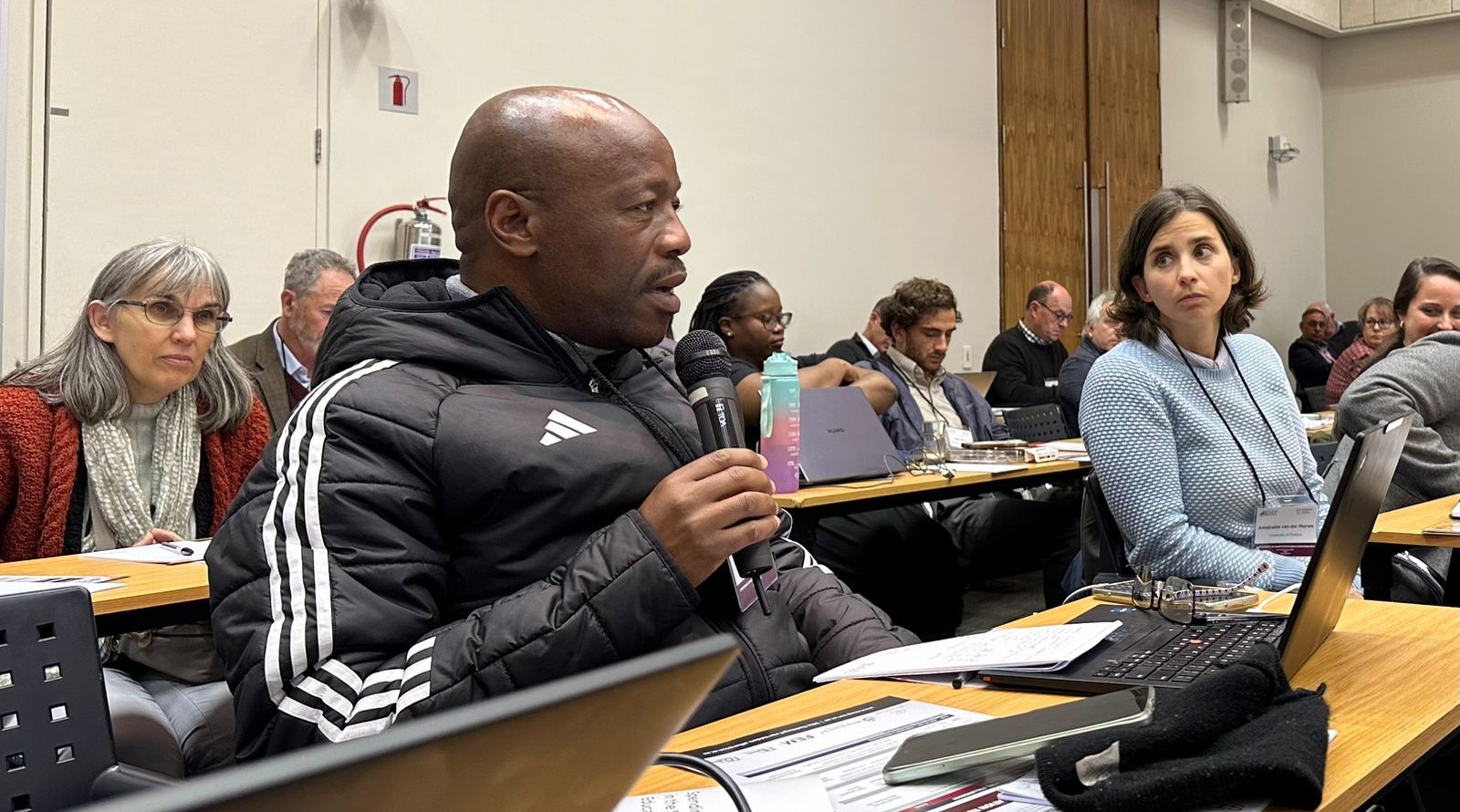 In the spirit of education planning, Lunga Swelindawo (DBE, Resep) examined the closure of small schools in South Africa, illustrating that while these schools on average have poor infrastructure, closing these schools may disrupt learning as reflected in matric results of affected learners.
In the spirit of education planning, Lunga Swelindawo (DBE, Resep) examined the closure of small schools in South Africa, illustrating that while these schools on average have poor infrastructure, closing these schools may disrupt learning as reflected in matric results of affected learners.
- Public finances and South African education
Quoting Michael Sachs, John Kruger (Resep) identified in his presentation that “core spending has fallen by R2,325 per South Africa from R30,440 (in 2019) to R28,116 (in 2023)” and debt servicing is overtaking social spending. With the large realignment of education spending to post-school education and training (PSET), it is necessary to reconsider the balance in spending between ECE, basic education and PSET. Yet more efficient spending within each sub-sector is also required, especially considering how finances will be allocated across university spending and NSFAS.
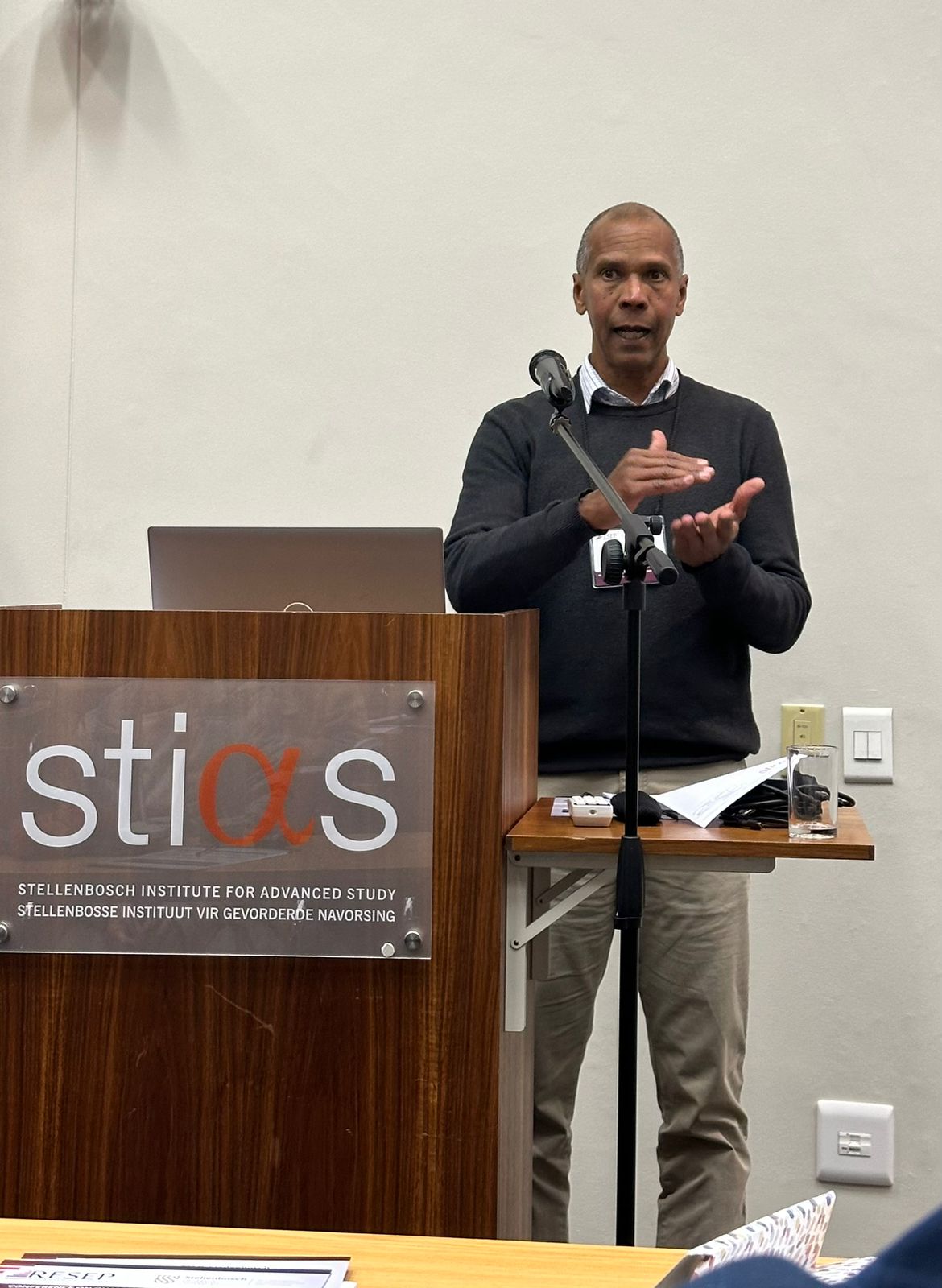 Spencer Janari (National Treasury) reiterated in his presentation that there is a shrinking share of spending of total education going to basic education. Of this budget, spending on teachers consumes a vast majority: compensation of employees as a share of basic education provincial budgets is over 90% after backing out conditional grants. A concerning pattern for early learning is that per learner spending on goods and services which was twice as much for secondary learners in 2013/14 than primary learners, has risen to nearly 3 times as much (2022/23). This reiterated Kruger’s concerns about disproportionate spending in education on older children.
Spencer Janari (National Treasury) reiterated in his presentation that there is a shrinking share of spending of total education going to basic education. Of this budget, spending on teachers consumes a vast majority: compensation of employees as a share of basic education provincial budgets is over 90% after backing out conditional grants. A concerning pattern for early learning is that per learner spending on goods and services which was twice as much for secondary learners in 2013/14 than primary learners, has risen to nearly 3 times as much (2022/23). This reiterated Kruger’s concerns about disproportionate spending in education on older children.
- Learner progression in recent years, with a closer look at the data that supports these analyses
The Data Driven Districts (DDD) team have been working hard to facilitate improvements in the quality of data inputs from schools, and the useability of that data for education planning purposes. Khodani Makatu and Jef Jacobs from the New Leaders Foundation explained the process by which DDD implement automatic mechanisms to support improved data quality across the entire data flow journey. In their presentation they also provided useful examples of the type of data that can be viewed on the DDD dashboards.
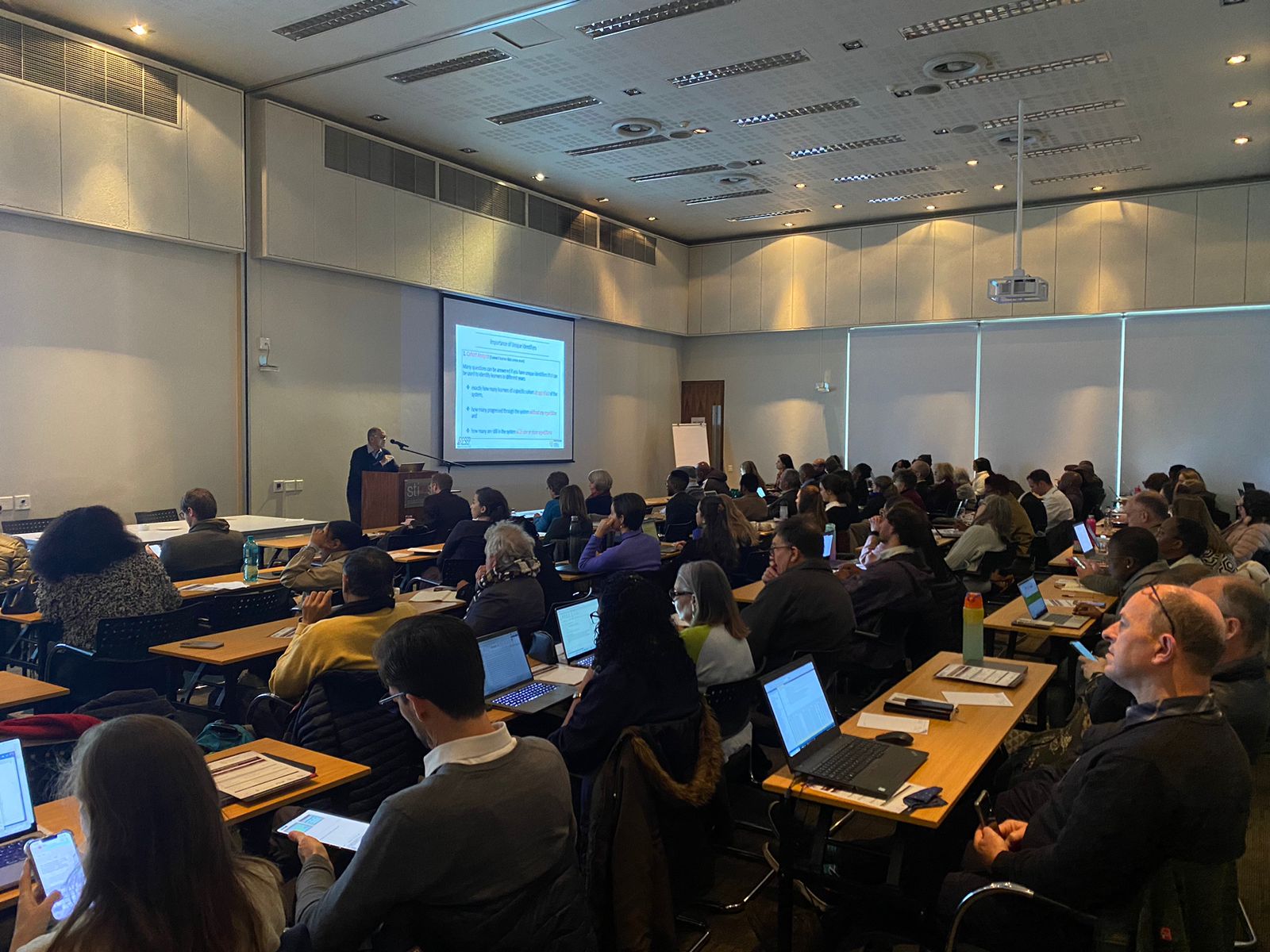 Benefiting from the work of DDD, in an analysis of SA-SAMS data from six provinces, Chris Van Wyk and Servaas van der Berg show in their presentation how learner flows through school have increased post-covid compared to a pre-covid period. But repetition rates (which declined during the pandemic) appear to be reverting closer to pre-pandemic repetition rates – especially at the FET phase. Although the difficulty of school-based assessment declined during the pandemic, this problem has not fully reverted to pre-pandemic levels. On a positive note, van der Berg also identified improvements in systems of assessments in schools in Gauteng, evidenced in higher correlation between school preliminary assessments and mathematics examination results.
Benefiting from the work of DDD, in an analysis of SA-SAMS data from six provinces, Chris Van Wyk and Servaas van der Berg show in their presentation how learner flows through school have increased post-covid compared to a pre-covid period. But repetition rates (which declined during the pandemic) appear to be reverting closer to pre-pandemic repetition rates – especially at the FET phase. Although the difficulty of school-based assessment declined during the pandemic, this problem has not fully reverted to pre-pandemic levels. On a positive note, van der Berg also identified improvements in systems of assessments in schools in Gauteng, evidenced in higher correlation between school preliminary assessments and mathematics examination results.
- Matric trends and quality before, during and post-Covid-19 and how this is relates to the labour market
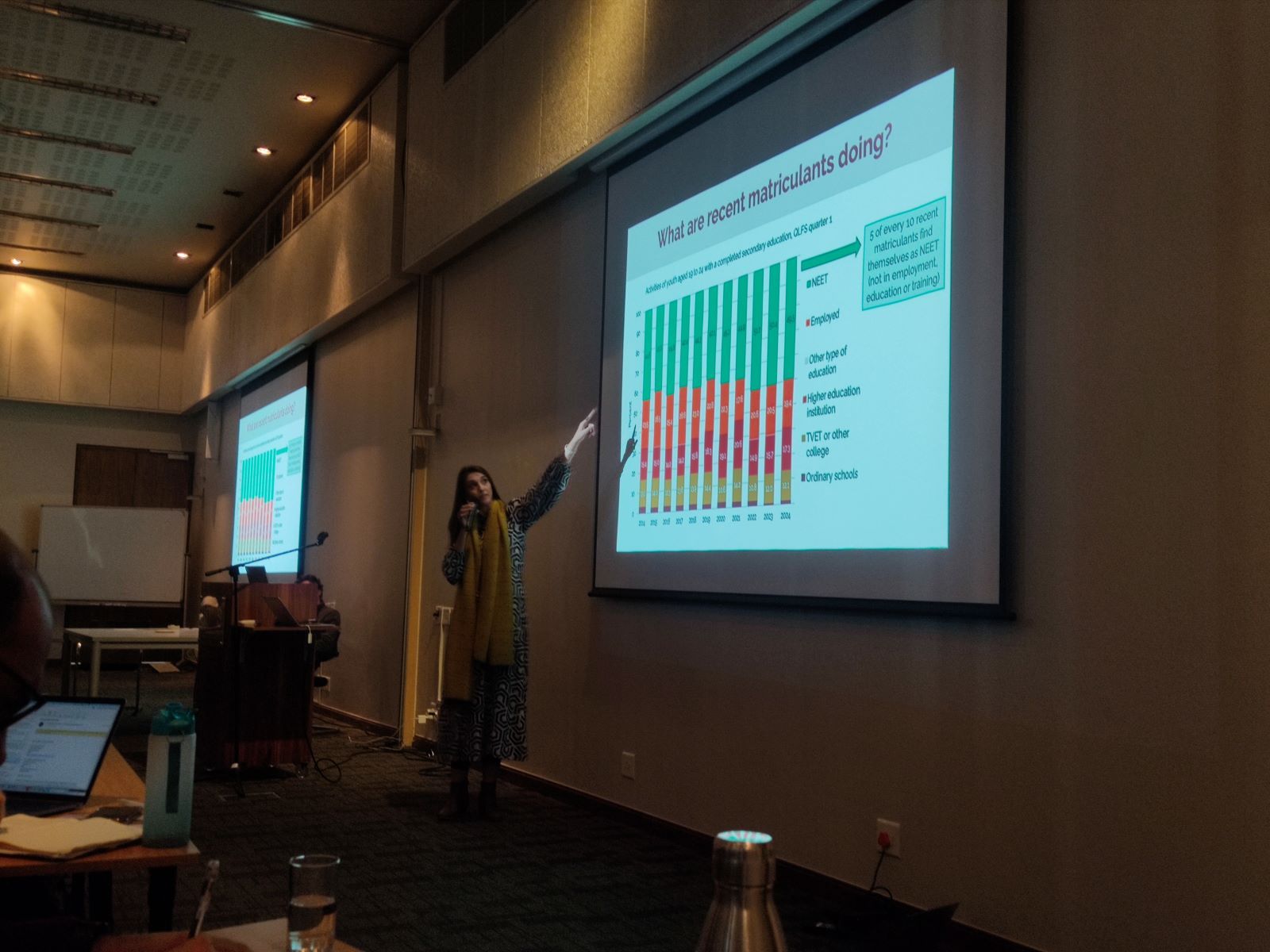 A panel session was dedicated to matric results as part of the Covid-Generation project on day 2. Over the Covid-19 pandemic, record numbers of candidates wrote the National Senior Certificate, passed or achieved Bachelor passes. Despite learning losses experienced in lower grades, matric performance was buoyant. Rebecca Selkirk (Resep) provided an overview of the positive trends in NSC performance (including declining inequalities in NSC outcomes) from 2008 to 2023. Any positive trends should, however, be viewed against the many factors that influence NSC results from one year to the next.
A panel session was dedicated to matric results as part of the Covid-Generation project on day 2. Over the Covid-19 pandemic, record numbers of candidates wrote the National Senior Certificate, passed or achieved Bachelor passes. Despite learning losses experienced in lower grades, matric performance was buoyant. Rebecca Selkirk (Resep) provided an overview of the positive trends in NSC performance (including declining inequalities in NSC outcomes) from 2008 to 2023. Any positive trends should, however, be viewed against the many factors that influence NSC results from one year to the next.
 In the presentation that followed by Emma Whitelaw and Nicola Branson (SALRDU, UCT), the question of grade inflation in the NSC was tackled by comparing NSC results to National Benchmark Test (NBTs) results of applicants to UCT before and during the pandemic. Similar conclusions are reached as discussed in their research note.
In the presentation that followed by Emma Whitelaw and Nicola Branson (SALRDU, UCT), the question of grade inflation in the NSC was tackled by comparing NSC results to National Benchmark Test (NBTs) results of applicants to UCT before and during the pandemic. Similar conclusions are reached as discussed in their research note.
 Tim Köhler (UCT, Resep) and Gabrielle Wills (Resep) closed the panel by exploring questions such as “what are these new matriculants doing?”, “how may the rising supply of matriculants shift the returns to education (if at all)?” and “has greater education attainment translated into better labour market prospects, in terms of employment and earnings?”. Despite rising school completion rates, youth and recent matriculants increasingly find themselves not in employment, education or training (NEET). Employment probabilities have reduced, for all levels of education but higher levels of education (specifically at least matric) still translate into better employment and wage prospects.
Tim Köhler (UCT, Resep) and Gabrielle Wills (Resep) closed the panel by exploring questions such as “what are these new matriculants doing?”, “how may the rising supply of matriculants shift the returns to education (if at all)?” and “has greater education attainment translated into better labour market prospects, in terms of employment and earnings?”. Despite rising school completion rates, youth and recent matriculants increasingly find themselves not in employment, education or training (NEET). Employment probabilities have reduced, for all levels of education but higher levels of education (specifically at least matric) still translate into better employment and wage prospects.
- Trends in mathematics, and social influences on Grade 9 mathematics Performance
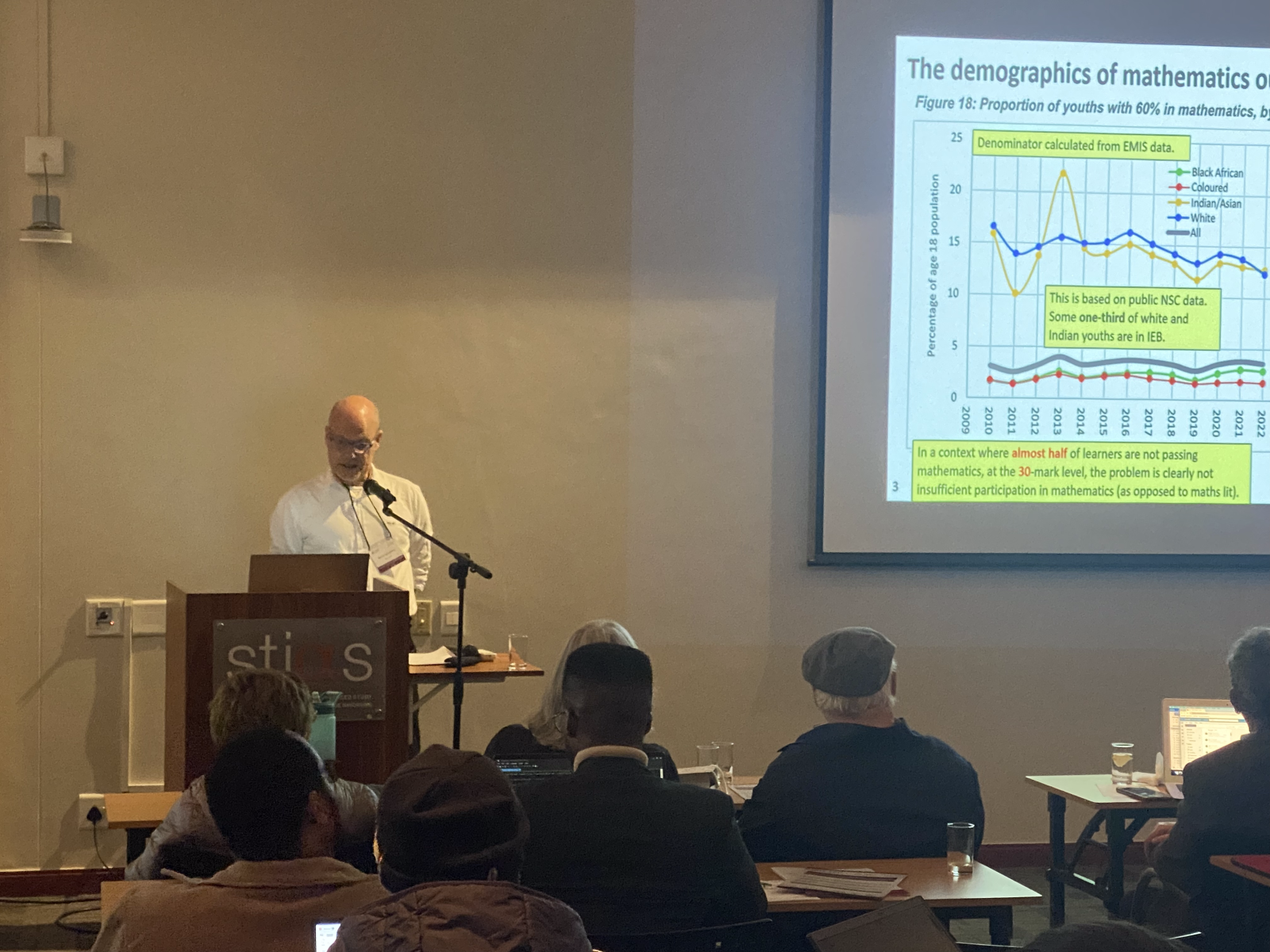 Martin Gustafsson’s (DBE, Resep), presentation sub-title summarises succinctly his findings on mathematics outputs in South Africa. There have been “Improvements, but [mathematics is] still a binding constraint for national development”. A key finding in his work is that “Despite large increases in NSCs with Bachelor- and Diploma-level endorsements, from a university perspective there is a concerning under-supply of mathematics skills from schools, even though university mark thresholds are quite lenient.” In lieu of altered grade repetition trends during and post-COVID, he argues that we should only insist on lower repetition in the final grades if we know this will not harm existing mathematics pipelines.
Martin Gustafsson’s (DBE, Resep), presentation sub-title summarises succinctly his findings on mathematics outputs in South Africa. There have been “Improvements, but [mathematics is] still a binding constraint for national development”. A key finding in his work is that “Despite large increases in NSCs with Bachelor- and Diploma-level endorsements, from a university perspective there is a concerning under-supply of mathematics skills from schools, even though university mark thresholds are quite lenient.” In lieu of altered grade repetition trends during and post-COVID, he argues that we should only insist on lower repetition in the final grades if we know this will not harm existing mathematics pipelines.
Despite reducing gaps in matric mathematics outcomes across boys and girls, Debra Shepherd (Resep) in work with Glen Takalani (Resep) illustrates how grade 9 boys and girls have quite different views or opinions of mathematics. In estimating how these differences in views affect test scores, it is essential to pay attention to construct bias and measurement invariance in learner’s responses to self-reported questions.
- Interventions –small short-term studies and long-term impacts of large interventions
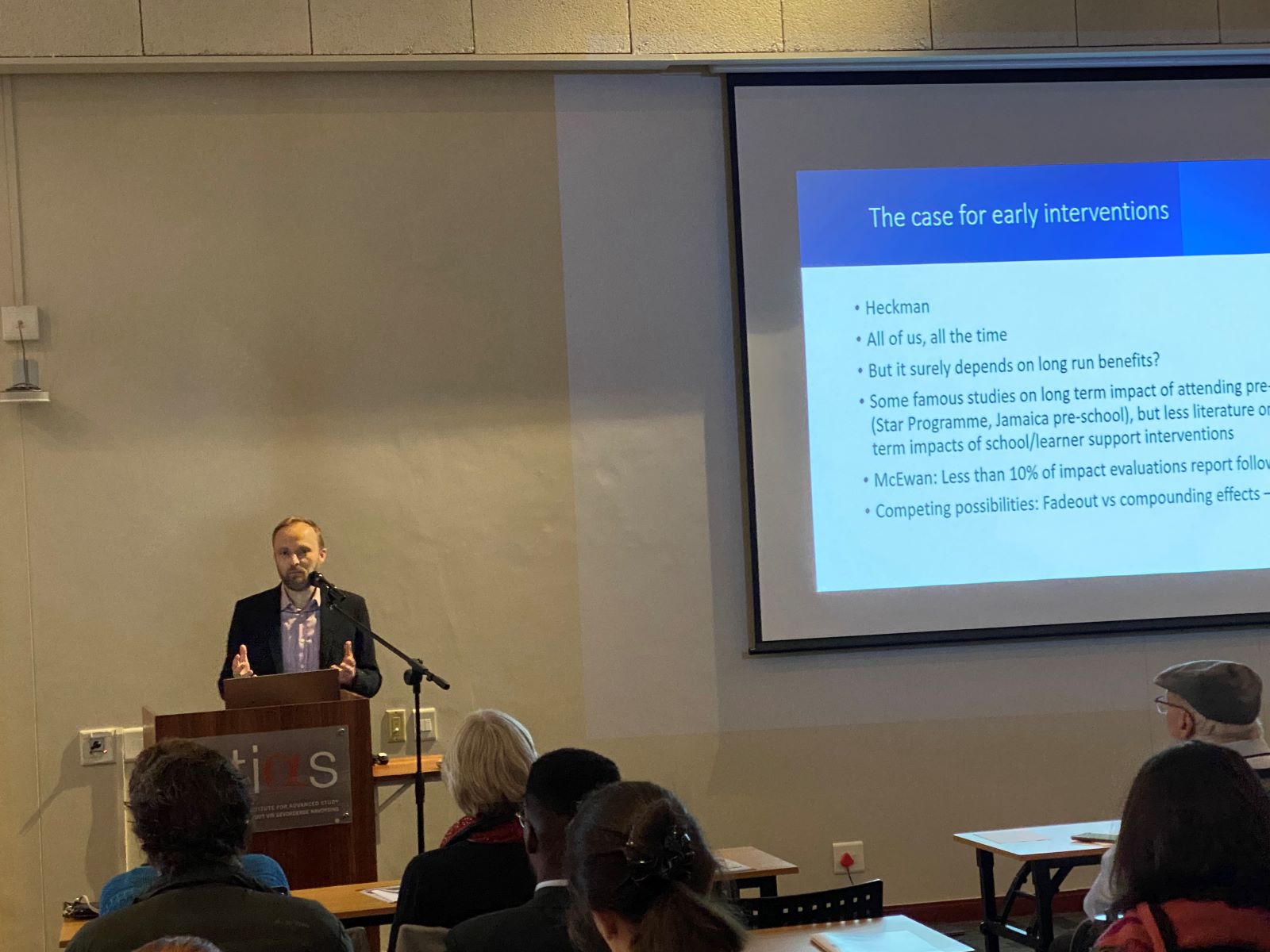 Three presentations focused on measuring the effectiveness of early learning interventions in South Africa. Asanda Lobelo (SALDRU, UCT) in hertitled “The use of early grade reading benchmarks to improve the efficacy of assessment in African languages”, discussed the results of a randomized control trial which exposed teachers to training on using newly established reading benchmarks to improve their awareness of children’s reading levels. Teachers tend to overestimate the reading ability of learners in their class. The short training was not as successful as hoped for in rectifying this, however, it was a very light touch intervention.
Three presentations focused on measuring the effectiveness of early learning interventions in South Africa. Asanda Lobelo (SALDRU, UCT) in hertitled “The use of early grade reading benchmarks to improve the efficacy of assessment in African languages”, discussed the results of a randomized control trial which exposed teachers to training on using newly established reading benchmarks to improve their awareness of children’s reading levels. Teachers tend to overestimate the reading ability of learners in their class. The short training was not as successful as hoped for in rectifying this, however, it was a very light touch intervention.
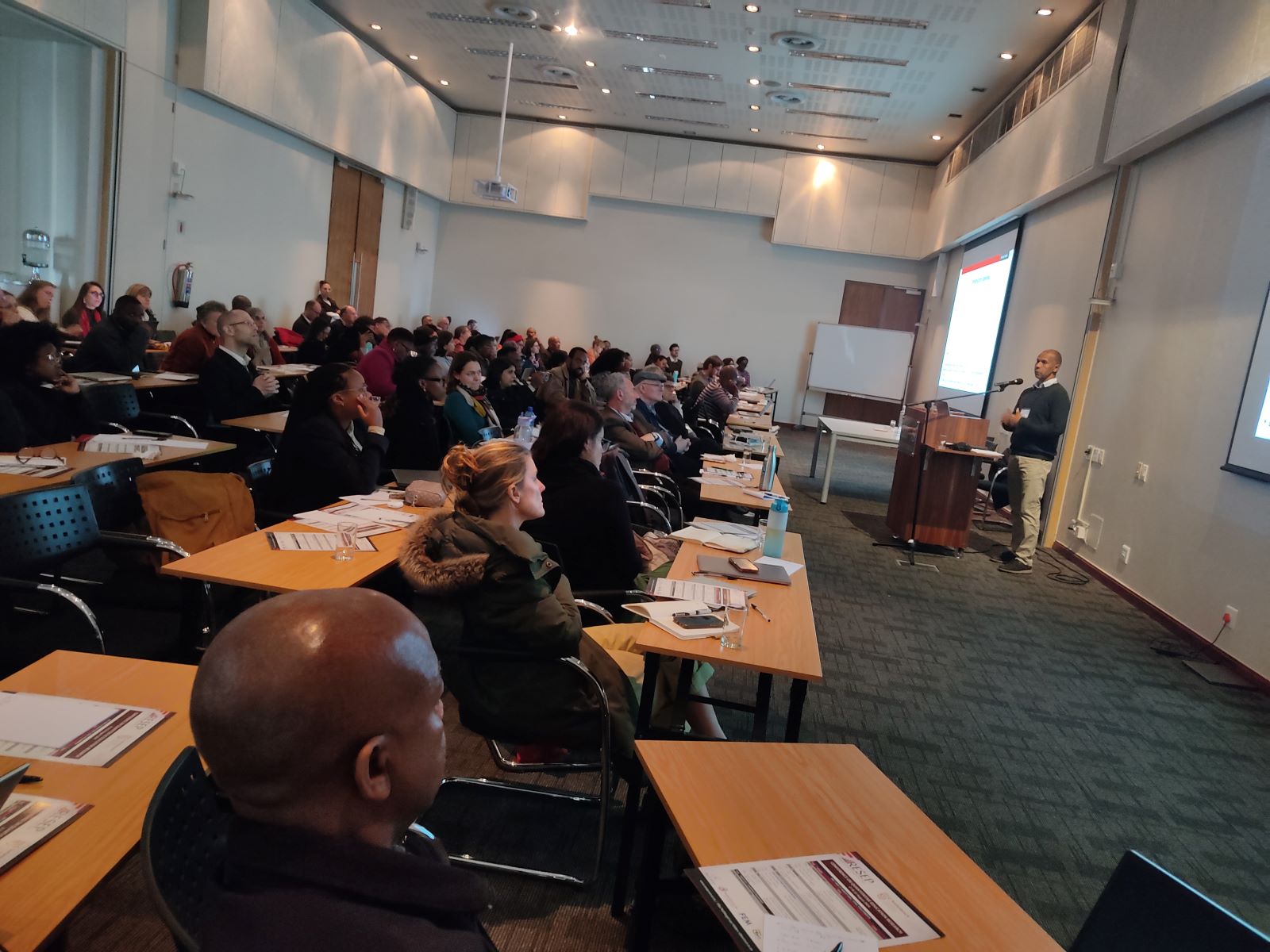 Brahm Fleisch (WITS) then presented on the effects of Teaching Assistants on letter-sound knowledge of Foundation Phase learners in South Africa. Learner’s letter-sound knowledge increased significantly over the short intervention period, suggesting that teacher assistants can be used to meaningfully support literacy development.
Brahm Fleisch (WITS) then presented on the effects of Teaching Assistants on letter-sound knowledge of Foundation Phase learners in South Africa. Learner’s letter-sound knowledge increased significantly over the short intervention period, suggesting that teacher assistants can be used to meaningfully support literacy development.
 Stephen Taylor (DBE) by linking learners from Annual National Assessment (ANA) data to matric, provides evidence of whether early learning interventions, specifically access to Grade R and home language instruction, impact on learning in the long-term, as reflected in matric performance. These large interventions are found to have negligible long-term learning effects, despite some short-term benefits, and effects are very small compared to the influence of demographic and socio-economic factors. Taylor leaves us with an interesting question: Would efficiency gains through reducing repetition and over-aged learners be a more cost-effective approach than early interventions, especially for boys?
Stephen Taylor (DBE) by linking learners from Annual National Assessment (ANA) data to matric, provides evidence of whether early learning interventions, specifically access to Grade R and home language instruction, impact on learning in the long-term, as reflected in matric performance. These large interventions are found to have negligible long-term learning effects, despite some short-term benefits, and effects are very small compared to the influence of demographic and socio-economic factors. Taylor leaves us with an interesting question: Would efficiency gains through reducing repetition and over-aged learners be a more cost-effective approach than early interventions, especially for boys?
Conclusion and thanks
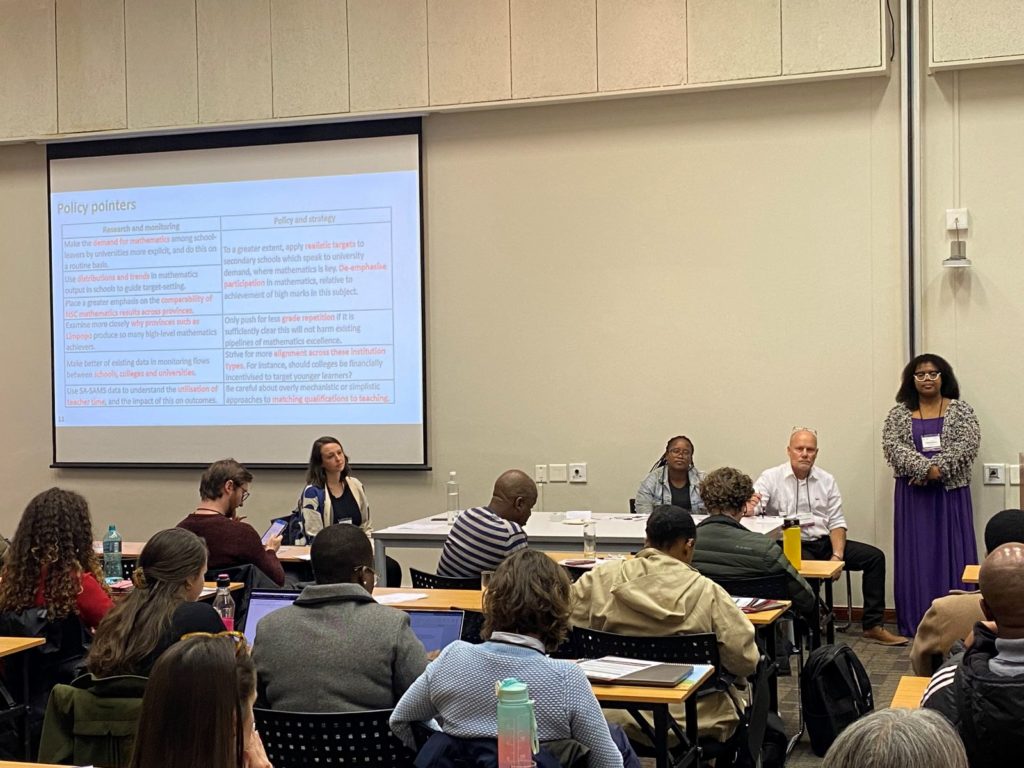 We are grateful for the contributions and time committed to this event by all speakers, chairs and participants, and of course our dedicated administrative team at Resep. The QER would also not have been possible without generous funding from FEM, the Michael & Susan Dell Foundation, The Epoch & Optima Trusts, and Allan and Gill Gray Philanthropies South Africa.
We are grateful for the contributions and time committed to this event by all speakers, chairs and participants, and of course our dedicated administrative team at Resep. The QER would also not have been possible without generous funding from FEM, the Michael & Susan Dell Foundation, The Epoch & Optima Trusts, and Allan and Gill Gray Philanthropies South Africa.
Servaas van der Berg closed off the conference, reflecting that “Each year, QER just seems to get better.” This may be due to the growing maturity of the research community, improved data quality and research developments. But what this statement also reflects are the stronger connections that have developed across the plethora of stakeholders represented at QER each year. From one year to the next, you know someone just a little better, and this makes all the difference.




